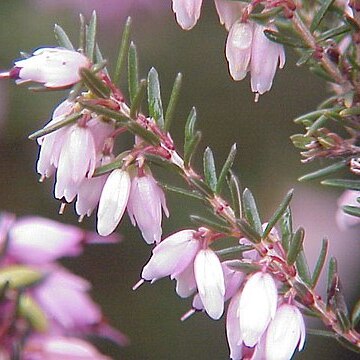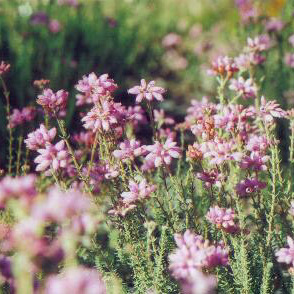Small to large, usually evergreen shrubs and small trees, very rarely epiphytic. Lvs simple, linear (or apparently very narrow because of revolute margins), opposite or whorled; petiole short. Infl. usually terminal, less commonly axillary, composed of umbels or racemes, sometimes paniculate. Fls nearly always subtended by bracts and bracteoles. Calyx of 4-(5) free sepals or deeply lobed, rarely shallowly lobed, sometimes petaloid, persistent. Corolla 4-(5)-lobed, deciduous or persistent; tube cylindric, campanulate or urceolate, widened or constricted at mouth; lobes usually < tube. Stamens 8-(10), included or exserted; anthers opening by lateral pores or slits, with or without awns. Capsule loculicidal, with many minute seeds.
Fls 4-merous; sep distinct; cor ovoid to campanulate, shallowly lobed; stamens 8; anthers with or without appendages; capsule subglobose, enclosed by the persistent cor; branching shrubs with narrow, whorled, subsessile lvs and pink to purple fls. 600+, Old World. Our spp. all intr. from Europe.
Inflorescence normally consisting of capitate clusters of up to 20 flowers on the tips of the branchlets, but sometimes spicate with the flowers in the axils of leaves on branches whose vegetative growth may continue after flowering.
Leaves normally in whorls of 3–6 (3–4 in the F.Z. area), or occasionally spirally insertedd, very small, the margins usually revolute and meeting in the centre line on the under side of the leaf to form a sulcus.
Stamens normally 8, rarely fewer (4–7) or more (12); filaments free, insertedd on a hypogynous disc, often geniculate below the anthers; anthers often with appendages, dehiscing by lateral pores.
Pedicels short and 1–flowered, normally bearing 1 bract and 2 opposite bracteoles, but sometimes either the bract or the bracteoles, very rarely both, missing.
Corolla globular to tubular, 4–lobed, the lobes usually appreciably shorter than the tube, in the F.Z. area rather to very small, always less than 1 cm.
Fruit a cartilaginous loculicidal capsule contained within the persistent calyx and corolla.
Trees, shrubs, or sub–shrubs, usually much branched with flexuously ascending sterns.
Calyx segments 4, free or fused to a greater or lesser extent.
Calyx and corolla actinomorphic and hypogynous.
Style 1, more or less expanded at the apex.
Ovary 4 (8) loculate, placentation axile.
Seeds several per loculus.
Branchlets slender.


